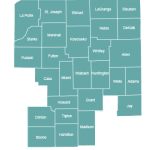Obamacare health insurance plans in Indiana for 2016 have been filed with the Department of Insurance. Once again, individual and family medical coverage is available through several companies with instant federal subsidies provided to households that meet the Federal Poverty Level (FPL) guidelines. Hoosier residents can not be denied for medically-related conditions when enrolling for Exchange policies.
Open Enrollment
Open Enrollment began on November 1st and ends on January 31st (2016). During this three-month period, no special exemption is needed to obtain guaranteed-approved plans that are eligible for federal subsidies and coverage for pre-existing conditions. Applying for coverage now takes approximately 10-25 minutes, instead of 60-90 minutes (last year). The new streamlined approach saves you time, frustration, and money!
Our website allows you to quickly obtain a policy at the guaranteed lowest available rates. Whether it’s Anthem, UnitedHealthcare, Aetna, MDwise, Ambetter, or any other company, lower prices (by law) can not be offered anywhere else. Our 35 years of expert advice and plan comparisons will help you every step of the way. NOTE: Humana and Assurant no longer offer Exchange contracts.
Navigator precertification, training and continuing education also helps Hoosier residents understand many of the changes that are effective for 2016. Lists of training and PE course providers are available to the public. Of course, we are required to submit agent and broker FFM registration to verify proper licensing and compliance. Continuing education is also required every other year.
Latest Enrollment News: If you forgot to sign up for a plan, you may still be able to enroll by taking advantage of an SEP (Special Enrollment Period) exemption. Otherwise, there are also numerous policies that can be purchased that will offer quality benefits at a price that fits within your budget. However, plans non-compliant with Obamacare may not offer federal subsidies or pay for certain pre-existing conditions.
Rate Changes From 2015 To 2016
Projected prices for private plans will greatly vary, depending on the carrier. While some companies have lowered rates by as much as 10%, other carriers have increased premiums as much as 50% on selected plans in specific areas. Large rate hikes are mainly due to increased claims by existing policyholders and higher overall medical expenses charged by physicians, hospitals, inpatient and outpatient facilities, and other related costs.
NOTE: For many areas, Anthem and UnitedHealthcare are offering the most competitive prices. MDwise, in selected counties, also offers affordable options. Three of the least expensive policies offered are the Anthem Bronze Pathway X 20, Anthem Bronze Pathway X 0, and UnitedHealthcare Bronze Choice HSA 4900. Ambetter also offers very competitive options in Indianapolis and other areas.
Although several other states manage and operate their own Exchanges, Indiana will continue to allow the federal government operate its Marketplace, including administration and software updating and management. Why? It’s all about money. Although having the flexibility to expand the Open Enrollment period would be beneficial, the $40-$50 million annual cost of maintenance would have to be accounted for. At this point, allowing a federally-run Exchange is the most cost-efficient.
Off-Marketplace Options
“Off-Exchange” policies are also available. These plans do not involve the federal healthcare website. Since the Obamacare subsidy does not apply, they should only be considered for high-income earners that are not eligible for financial aid. Most carriers that offer policies “on” the Marketplace, offer “off” plans as well.
Prices and benefits are similar to “on-Exchange” policies (sometimes the cost is less), and often the number of network providers is expanded with additional specialist and facility options to choose from. Also, the application process is more streamlined and policy approvals occur very quickly, instead of waiting for a few weeks. The federal website is not utilized, and thus, many hours (days) of administrative work are not needed.
Non-Compliant Options

Also available are “non-compliant” policies which are also purchased away from the Marketplace. The most common (and popular) type of coverage is a short-term contract designed to provide inexpensive major medical benefits. Rates are cheap and the application process takes less than 30 minutes. UnitedHealthcare is one of several carriers that offers temporary contracts.
We compare short-term health plans in Indiana by reviewing several of the carriers that specialize in this product. Contract provisions are very similar, although some of the available riders vary (such as life and disability benefits, critical illness, and extra accidental coverage). You can expect to pay out-of-pocket for many items that normally are covered in full or with a copay. Examples include preventative benefits (annual physical, OBGYN exam, mammogram) primary-care office visits, non-generic prescriptions and trips to Urgent-Care.
But they do not bypass the special penalty for not having complaint coverage, so you may have to pay an additional tax of up to 2.5% of your adjusted gross income (up from 1% in 2014). If you only utilize this type of policy for a portion of the year, your penalty will be pro-rated. Generally, the first three months of the year you are not complying with the law result in no fine or penalty.
Other “non-compliant” plans include critical illness and “specific disease” plans. This form of policy is designed to supplement existing Exchange coverage by paying a portion (often a large portion) of your out-of-pocket costs if you are treated for a specific disease or illness. But when they act as “stand-alone” coverage, they don’t meet ACA guidelines. Typically, we do not endorse these contracts since major medical expenses could be left uncovered.
Affordable Care Act Legislation And Its Impact In 2016
Another factor is that 2014 was the first year that health insurance companies were not able to “underwrite” plans based on existing and pre-existing conditions. Only smoking status, age and zip code can be used when determining the cost of coverage. Of course, the federal tax credit substantially reduces premiums for many Hoosier residents. About 9 out of every 10 applicants in 2014 and 2015 qualified for a subsidy.
For 2016, the vast majority of applicants will receive financial assistance. Medicaid is now offered to lower-income single persons and families. A plan to expand Medicaid is currently being considered by the Center for Medicare and Medicaid Services. “Healthy Indiana Plan 2” may become a reality within the next 3-6 months. The federal waiver request, if approved will provide low-cost medical benefits to more than 300,000 additional persons in the state.
Missed The Deadline?
For consumers that miss Open Enrollment, there are many available options, including temporary policies (designed to be kept less than 12 months) and “qualified life events” that allow a special exception to be made. We discuss them here and they are offered all year. For example, if you lose coverage because of a divorce, loss of job, cancellation or non-renewal of plan, or move to a different area, you are granted approximately 60 days to enroll in a new plan.
If you don’t qualify for any of the many approved exceptions, as mentioned above, an extremely inexpensive option is to purchase a short-term policy until the next OE period. Premiums are cheap, policies can be approved within a few days (or less) and the two-page application takes less than 30 minutes to complete. Major medical expenses are well-covered. UnitedHealthcare is one of several carriers offering cheap rates.
But, short-term plans lack many of the new required benefits, so a special 2.5% household income surcharge applies. Any existing conditions are not guaranteed to be covered. Acceptance by the insurers is also subject to an underwriting review, which differs from Exchange plans. But often, if you have a gap in benefits and don’t qualify for a special enrollment exception, it’s your best recourse. However, since policies can only be kept for up to 12 months, they are not a permanent solution.
Anthem Plans

Anthem Blue Cross Blue Shield issues more policies than any other company in the state. They are requesting an increase between 9% and 10% on their individual business. The higher premiums are justified by the older ages of many applicants last year along with associated higher medical cost (as previously mentioned).
For 2016, Anthem offers a new portfolio of plans that utilize the cost-saving Pathway X network. Several of the most economical plans are listed below:
Bronze Pathway X 4950 50 – $5,000 deductible and 50% coinsurance. Cheapest non-catastrophic plan.
Bronze Pathway X 5850 35 – Similar to 4950 50 plan but with $5,850 deductible and 35% coinsurance.
Bronze Pathway X 20 For HSA – Nice HSA plan with $4,500 deductible and 20% coinsurance.
Silver Pathway X 4250 30 – Impressive $25 copay for primary-care physician visits and $50 copay for specialists. Coupled with a $4,250 deductible, this plan should always be considered if you qualify for a federal subsidy.
MDwise
MDwise filed for a rate increase on most plans. Although not one of the “big players” in the state, it was hoped that they could gradually increase market share. With slight increases expected in 2016, competitive pricing is expected. In selected areas, their prices will be lower than most other companies. The most competitive plans offered by MDwise are listed below:
Marketplace Bronze Basic – Low $20 pcp office visit copay, which is unusual for Bronze-tier options. Deductible is $6,200.
Marketplace Bronze Plus – Similar to previous plan, but with $10 pcp copay and $4,800 deductible.
Marketplace Silver Basic – No charge for pcp office visits and $5,000 deductible. Plan is eligible for “cost-sharing.”
Marketplace Silver Plus – Similar to prior plan, but with lower deductible ($2,500) and higher generic drug copay ($20 vs. $15).

Physician’s Health Plan (PCP)
Last year, the largest proposed increase was submitted by Physician’s Health Plan with a 46% request. Their network covers only Northern Indiana and some of the Central counties, so most residents are not impacted. Their most popular policy options are shown below:
Marquee HSA Bronze 6000 – HSA-eligible plan with $6,000 deductible.
Marquee Bronze 5000 (HMO and POS) – $5,000 deductible with $50 copay (and 50% coinsurance) on pcp office visits.
Marquee HSA Bronze 3750 – HSA-eligible plan with $3,750 deductible and 40% coinsurance.
Marquee HSA Silver 3500 – HSA-eligible plan with $3,500 deductible and $4,500 maximum out-of-pocket expenses.
Marquee Silver 2000 – $2,000 deductible with $30 copay on pcp office visits.
Marquee Gold 1250 – Low $1,250 deductible with $35 pcp office visit copay. Generic drug copay is $15.
Ambetter
Ambetter offers many low-cost plans in the central and northwestern portion of the state, along with four counties located in the southern region. In addition to competitively-prices policies, also available is optional dental and vision benefits, a 24/7 nurse line, member wellness health incentive program, and very comprehensive prescription coverage on upper-tier plans.
One of the cheapest options for single and family households is the Bronze Essential Care 1,2, and 3 plans. Each policy offers optional dental and vision benefits that are extremely inexpensive. For example, a 50 year-old in Hendricks County that makes $24,000 per year, will pay only $94 per month for the “1” policy.
Adding dental and vision coverage will only increase the rate by $31 to $125. Although the deductible is high, each of the 10 “essential health benefits” are included. Shown below are popular low-cost plan options:
Essential Care 1 – $,6800 deductible with $20 generic drug copay.
Essential Care 5 – Three free pcp office visits and a $6,800 deductible.
Balanced Care 2 – Cheapest Silver-tier plan with $25 and $50 office visit copays and a $4,500 deductible.
Balanced Care 1 – Office visit copays of $20 and $30 with lower $3,500 deductible.
Balanced Care 10 – Very low $10 and $20 office visit copays along with $5 generic drug copay. Deductible is $4,000.
Secure Care 1 – Gold-tier plan with $1,000 deductible but no copays for office visits and maximum out-of-pocket expenses of $6,350.
Additional Companies Offering Coverage
There are also four new carriers that offer 2016 on-Exchange plans. Proposed premiums were approved by the Department of Insurance. The four companies are:
All Savers (UnitedHealthcare).
Care Source, which is a managed-care company.
IU Health Plans began offering plans in 2016. They partner with the Indiana University School of Medicine, and offer very competitively-priced plans in their service area. In addition to single and family Marketplace plans, IU Health also offers Medicare Advantage plans in Indiana. Listed below are several of their most popular and affordable policies for applicants under age 65:
Bronze Simple HSA – $6,500 deductible and HSA-eligible.
Bronze Value – $6,000 deductible with $40 copay on pcp office visits and $16 generic drug copay.
Silver HSA – $3,000 deductible and HSA-eligible. $4,500 maximum out-of-pocket costs.
Silver Copay – $30 and $60 office visit copays with $2,500 deductible.
Gold Value – Low $750 deductible with $20 and $50 office visit copays. $9 copay for generic drugs.
Southeastern Indiana Health Organization, who, as expected, will offer policies predominantly in one portion of the state.
We will continue to keep you informed of any changes for 2016 and how to easily enroll in the most affordable health insurance plans in Indiana.
UPDATES:
August 2014 – A lawsuit seeking to end federal subsidies for the purchase of health insurance will proceed to trail. Initiated by Governor Pence, the basis of the lawsuit is that Indiana did not set up a state Marketplace (instead opted for federal), and therefore should not receive the Obamacare tax credits.
Pence has stated that he feels it is unconstitutional to force consumers to buy coverage and subsequently face tax penalties for non-compliance. More than 100,000 Hoosiers received subsidies in 2014 when purchasing Exchange plans.
It is expected that this lawsuit will not ever reach the point where a jury is picked. Similar lawsuits have already been filed, and are expected to be settled by the US Circuit Court of Appeals.
October 2014 – NorthShore Health Centers (in Portage) has been granted $1.5 million from HHS to help treat patients in the Northwestern portion of the state, including Lake and Porter Counties. Treatment is offered to persons in the area that either have not enough or no coverage.
November 2014 – UnitedHealthcare is offering several very attractive 2015 policy options. The Silver Choice 2000 plan features a fairly low $2.000 deductible with copays on most office visits and prescriptions ($30-primary care physician). The Gold Choice 1250 offers a $1,250 deductible with very low copays on primary care physician and specialist visits ($10 and $30 respectively). It’s actually less costly than many Bronze and Silver policies.
March 2015 – An upcoming Supreme Court Ruling will have a huge impact on about 200,000 Hoosier residents. King Vs. Burwell impacts federal subsidy availability in states that have not set up their own Marketplace. Although the legislation originally intended that all persons would be eligible for financial assistance, regardless of the status of their State Exchange, the exact verbiage did not match the intent.
A decision is expected this summer although regardless of the outcome, 2015 subsidies may not be affected since a quick temporary legislative fix can probably be enacted.
November 2015 – Federal subsidies were upheld in the King Vs. Burwell ruling. We don’t anticipate any major legal challenges until possibly 2017. However, minor court rulings can be expected on the legality of requiring contraceptive coverage in certain employer-based plans.

